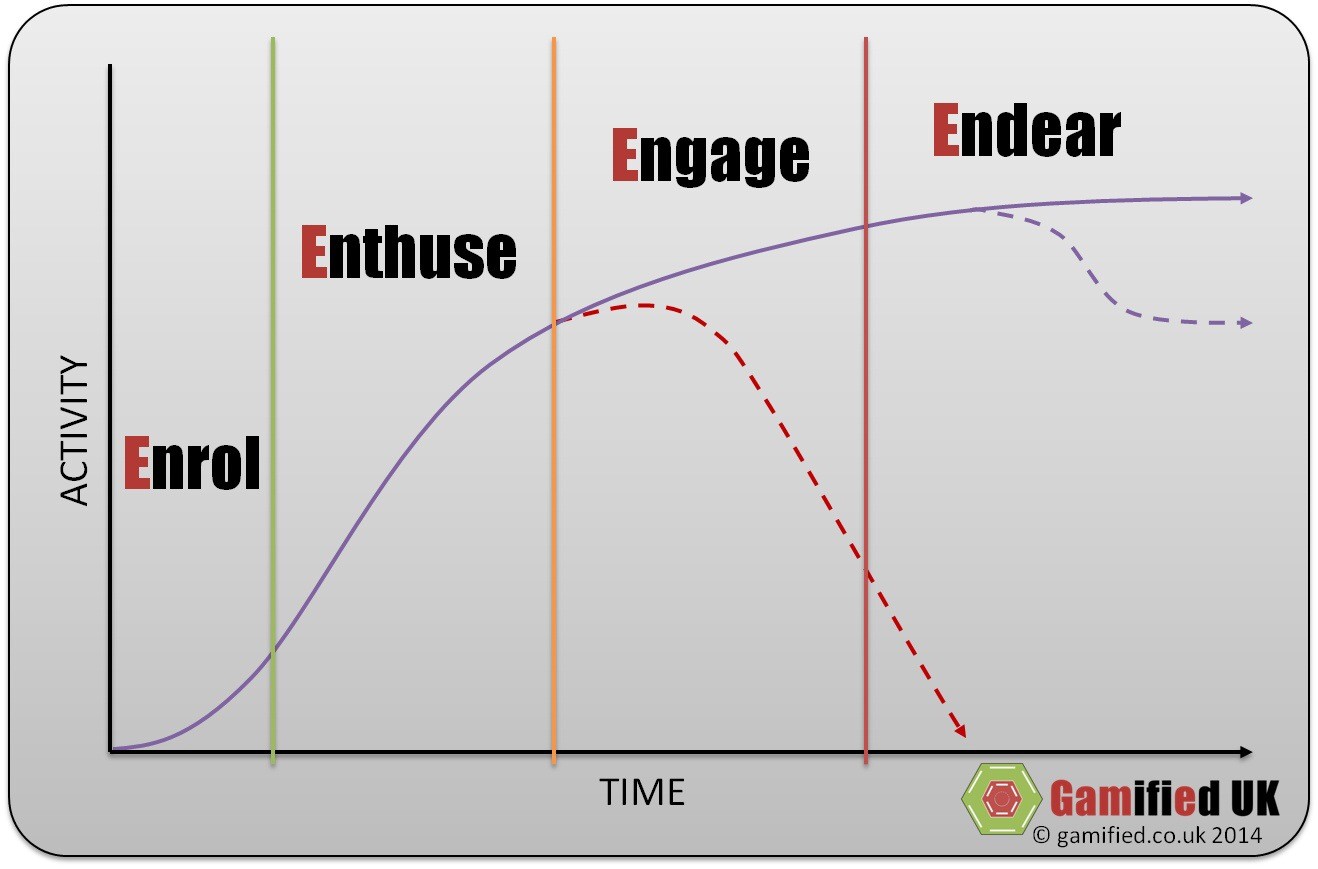Over the past weeks as I have been re-writing chunks of my book and preparing for various talks, I have been trying to consolidate a lot of my ideas. This has so far lead to four basic frameworks.
RAMP, GAME, EEEE and User Types. There is a big infographic at the end of this post that goes over them, but in brief
RAMP: My intrinsic motivation framework that I have spoke about before. Relatedness, Autonomy, Master, Purpose.
GAME: An update of my original development process framework. Gather, Act, Measure, Enrich. I will speak about this in the next blog post.
User Types: You probably know my User Types Hexad by now, I talk about it a little here. Philanthropists, Disruptors, Free Achievers, Spirits, Players, Socialisers
EEEE: This one is about user and design journeys and what I will spend the rest of the blog on. Enrol, Enthuse, Engage, Endear.
EEEE Framework
I have long been a fan of Amy Jo Kim’s Player Journey over Time concept. It has formed the core of lots of my work and will continue to do so. However, at times it is not enough to describe every phase of the users journey and experience of your gamified system. As such, I have created EEEE: Enrol, Enthuse, Engage, Endear. Yes – it seems a little forced I will grant you – but just hold on and let me tell you about it!
Enrol
Once a user has taken the first step and have decided to use your system, they have enrolled. From this point they begin to use the system. They usually start with a short period of activity whilst they learn the ropes. In Amy’s this is the On-Boarding phase.
Enthuse
Once they are over the initial learning curve, they often begin to enthusiastically “play” with the system – trying out everything that they can. Take a simple gamified website, where you are rewarded for commenting and liking etc. The Enthuse phase will see them adding lots of comments, liking things and pushing the boundaries of the system rules. This burst of activity will begin to level off though.
Engage
Once the enthusiasm of a new joiner has slowed, they need to enter the engaged phase. This is where they begin to use the system in a way more akin to what you had desired. This is a big drop out phase – if you have no plan beyond point giving, engagement is unlikely for any length of time.
Endear
This is where the user is in the system because they want to be. You have given them some reason to “love it”. Akin to the Mastery phase of Amy’s Journey, this is where they have become intrinsically motivated to stay and will continue to use the system at their own pace. It is in this phase that they may start to evangelise to others and help them on their journeys.
This chart shows the relative activity over time. You can see that after they initial burst , activity begins to level out. In fact, during the last phase it may drop – but it will continue.
Next post will be about the GAME design framework 🙂

I so needed this, Andrzej! I’m struggling to get my system and my students to be engaged so I need to develop the endearment. I use 3D GameLab and it’s great at distributing points and badges but kids need more. I need a story.
Actually, that is a great point. I should really add the idea of story being part of what could make people “love” the system. Though often a narrative based system lacks replay value, so be careful 🙂
Thanks!
Andrzej Marczewski
Sent from my mobile device
Okay, so story alone may not be enough. What should I watch out for with adding a story element to my gamified course?
What else can I do to add replay value, to endear my gamified course (in my case, 6th grade Science)?
If it is a finite length (so they only HAVE to go through once), story is fine.
If there are game elements, some may enjoy something like high score attacks. Add an element of exploration for people (little Easter eggs to find).
Andrzej Marczewski
Sent from my mobile device